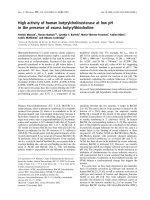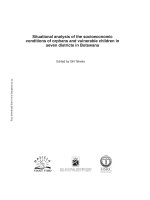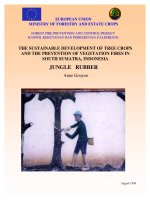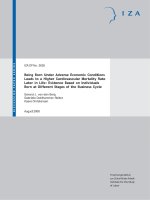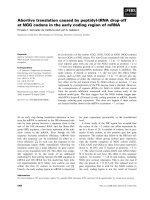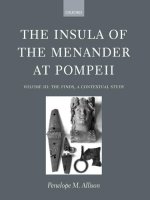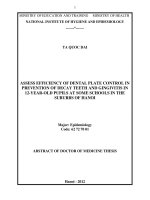Community-based ecotourism at Kadilangu mangrove conservation: The socio-economic development perspectives
Bạn đang xem bản rút gọn của tài liệu. Xem và tải ngay bản đầy đủ của tài liệu tại đây (550.51 KB, 11 trang )
COMMUNITY-BASED ECOTOURISM AT KADILANGU
MANGROVE CONSERVATION: THE SOCIO-ECONOMIC
DEVELOPMENT PERSPECTIVES
Dyah Titis Kusuma Wardani, MIDEC
Department of Development Economics, Faculty of Economics and
Business,Universitas Muhammadiyah Yogyakarta, Indonesia
Jalan Lingkar Selatan, Tamantirto, Kasihan, Bantul,
Daerah Istimewa Yogykarta 55183, Indonesia
Abstract
The conservation efforts by Kadilangu community have produced the enhancement
of mangrove forest areas, however the utilization of mangrove forest by people around
was limited. The conservation effort was analyzed descriptively based on Indonesia
Government Rule Number 5 in 1990 and Number 32 in 2004. To make the conservation
effort sustainable, it needs to develop community-based ecotourism (CBET) at Kadilangu
mangrove forest, so as they can utilize mangrove forest benefits. Mangrove forests protect
coastline by preventing abrasion, enrich coastal waters, support coastal fisheries, give
additional benefits for biodiversity, and improve ecotourism industry. This research
intended to study the conservation and ecotourism effort in Kadilangu Village and the
community perception of both conservation and ecotourism toward sustainable socioeconomic development. The data collection was undertaken through field visits and
interviews using simple random sampling. In addition, to investigate the ecotourism
potential at Kadilangu mangrove forest this research using components obtained from key
informants interview which are divided into four parameters. In addition, to estimate of
potential economic value of Kadilangu ecotourism mangrove forest with Travel Cost
Method (TCM). The Six-Pack Training Pilot Project is a recommendation to solve the
problem of CBET in Kadilangu. The results are supposed to give strategies on how
running the efficient training to maintain sustainable management of CBET therefore
conservation efforts as well as community‟s welfare improved significantly.
Keywords: community-based ecotourism (CBET), mangrove conservation, socioeconomic, sustainable development JEL Classifications: Z32, F64, O20, Q01
1. Introduction
Ecotourism is one of the important industrial sectors and has great potential and
opportunities to be improved. The government of Indonesia continues to develop the
ecotourism as a part of tourism sector that will become the new engine in supporting
national growth and sustainable development. Not only because this sector became one of
the sources of income, but also World Tourism Organization data of 1994 said that, in the
21st century, tourism become one of the most important socio-economic activities and
619
become one of the largest export industries in the world. The growth of Indonesian tourism
is very significant, the Ministry of Tourism and Indonesian Agency for Creative Economy
(BEKRAF) stated that, tourism growth is higher than the overall growth of the Indonesian
economy. The development of tourism in Indonesia is also increasing as the government of
Indonesia is targeting the visit of 20 million tourists in 2020. To realize the target, the
government is currently intensively promoting tourism in various countries, one of them in
New Delhi, India in the World Festival (WCF) (Ministry of Tourism, 2017).
1.1 Background
The fundamental purpose of ecotourism is to conserve the environment, at the same
time, to support poverty alleviation of the local people in line with the issue in Sustainable
Development Goals (SDGs) namely ―Green Economy‖. Sustainable development has been
the overall goal of the international community since 1992 in the UN Conference on
Environment and Development (UNCED). The conference invited governments to develop
national strategies for sustainable development, incorporating policy measures outlined in
the Rio Declaration and Agenda 21. Despite the efforts of many governments around the
world to implement such strategies as well as international cooperation to support national
governments, there are continuing concerns over global economic and environmental
developments in many countries addressing some issues related to global energy, food and
financial crises, and is underlined by further warnings from global scientists that
communities are in danger of breaking ecological limits. Thus, one of chapters in the
guidebook to the green economy1 is coherent with ecotourism in Indonesia, one of issue in
guidebook entitled, Towards a Green Economy: Pathways to Sustainable Development
and Poverty Eradication which is written by United Nations Environment Program
(UNEP). The green economy is defined by UNEP as one that results in improvement of
human well‐being and social equity, while significantly reducing environmental risks and
ecological scarcities.
1.2 Objectives
Based on green economy concept of SDGs, it is important to conduct the research
that aim to enhance ecotourism in Indonesia to comply with the United Nation program.
The first hypothesis is, although Kadilangu Sand Beach has produced the enhancement of
mangrove forest areas, however, the utilization of mangrove forests is still limited.
Therefore, it needs to develop community-based ecotourism (CBET) at Kadilangu
mangrove forest, in order to obtain the benefit of mangrove forests optimally. Mangrove
forests are not only useful because they produce wood, but also as a buffer for marine and
terrestrial ecosystems (Davis and Johnson, 1987). One of the benefits of mangrove forest is
to provide some food and nutrients for some marine animal species including those that
1
The term green economy was first coined in a pioneering 1989 report for the Government of the United
Kingdom by a group of leading environmental economists, entitled Blueprint for a Green Economy (Pearce,
Markandya and Barbier, 1989). The report was commissioned to advise the UK Government if there was a
consensus definition to the term ―sustainable development‖ and the implications of sustainable development
for the measurement of economic progress and the appraisal of projects and policies
620
have important ecosystem meaning (Blackwell, 2007). Nutrient elements and large amounts
of organic matter in these mangrove forests are mostly derived from the leaves of mangroves
and organisms that have died and broken down by microorganisms (Bengen, 2001). The
second hypothesis is, the managerial problem of CBET due to low skill of community.
1.3 Framework Analysis
Figure 1.1 Model of Community-Based Ecotourism (CBET) Kadilangu Mangrove Forest
Source: Author Estimation
1.4 Literature Review
1.4.1 Community-Based Ecotourism (CBET)
Empowerment is the language, from the Indonesian derived from the word "power"
which means strength, which means the effort to build a power possessed the poor by
encouraging, motivating, and raise awareness about their potential and try to develop
(Esack 2000). Six Pack-Training (Product, Price, Place, Promotion, People and Process)
initiative is a pilot project that will be implemented in ecotourism sites by empowering
local people. The project aims to build the capacities of local authorities and community
members, to enable them to manage community-based ecotourism become more selfsufficient and sustainable.
621
There are activities during the first few months revolved around community
mobilization and capacity-building for members of local ecotourism authorities and
ecotourism service providers. This research aims to investigate some potential of CBET at
Kadilangu to set up an ecotourism training program. Thus, from the result, ecotourism
training able to address the need of CBET at Kadilangu, so that the training program may
contributed to the improvement of quality service toward visitors both foreigner and
domestic, enhancement of conservation effort as well as community‘s welfare by
increasing trading activities surrounding mangrove forest to achieve sustainable socioeconomic development in the mangrove forest area (Fadhilah, 2015).
1.4.2 Tourism Elements
According to Spillane (1987) there are five elements of tourism such as attraction,
facilities, infrastructure, transportations and hospitality. According to Mathieson and Wall
(1982), tourism demand is the total number of people who travel to use tourism facilities and
services in a place far from where they live and where they work. The demand for tourism
affects all sectors economy, including: individual (individual), Small Business Medium
Enterprises, Private Companies, and Government Sectors (Sinclair and Stabler, 1997). The
demand for tourism is also based on the budget shopping that people have, this is the core of
demand tourism. Someone will consider to reduce the budget people have for a holiday interest.
2. Method
2.1 Object of the Research
The object of this study is visitors of mangrove forest tour at Kadilangu Beach
located in Yogyakarta. The study is conducted at Kadilangu since this tourism site is quite
new and potential to be developed. Besides this research is important since to investigate
sustainable management in mangrove conservation.
2.2 Data
The research is using quantitative method, where the data that is obtained is a
number, then further analyzed in a data analysis. Data used in this research is primary data
which is obtained directly from the source, they are, visitors of Kadilangu ecotourism and
Kadilangu Community. In addition, this research also apply qualitative method to get
details and further information to investigate on how substantial CBET contribution to
mangrove forest ecotourism as well as conservation effort built in the ecotourism program
by doing field observations and interviews to the key informant.
2.3 Sampling Technique
The simple random sampling method is the sampling method is a sampling method
that gives the same opportunity or opportunity for elements or members of the population
to be selected to be randomly sampled. The method used by accidental sampling is
technique sampling based on anyone who happens to meet with researchers and willing to
be respondents in Kadilangu mangrove forest. Advantages of this sampling method is an
easy sample selection procedure, moreover, misclassification can be avoided.
622
The minimum number of visits to Kadilangu mangrove forest during these 5 months is
1 times and a maximum number is 6 times. The lowest number of visits, 1-2 times at amount
87 respondents or 72.5% and the highest number of visits, 6 times at about 6 respondent or
equal to 5%. Description of number of visits can be seen in the following table:
Table 2.1 Number of Visits at Kadilangu Mangrove Forest
Number of Visits
(Times)
1-2
3-4
5-6
Number of Respondents
(People)
87
27
6
Percentage
(%)
72.5
22.5
0.5
Total
120
100%
The number of samples in this study using Slovin formula with the following
calculation:
Where,
n
= Sample
N
= Population
d
= Standard deviation
Therefore, the amount of sample size, if d = 10% for visitors mangrove forest
estimated as follow,
Then, sample size is 55 visitors.
2.4 Data Collection Technique
The data collection techniques is using in this research differentiated into two
techniques, they are as follow,
2.4.1 Key Informant Interview
It is a technique of data collection conducted by holding a verbal question and
answer. The task was to identify potential community based ecotourism (CBET) sites in
Sanden that might have been missed in the initial short listing. In the absence of relevant
data, stakeholders were relied on as both key informants and key players in the
implementation of ecotourism development activities. Key informant interviews, meetings
and discussions with relevant stakeholders were a vital part of the study since there was
insufficient or no publicly available information about community-based ecotourism in the
ecotourism site. Each stakeholder was provided with the list of the components and
parameters and asked to provide insights and give the score. The main objective of these
discussions was to use the expertise of the team members to identify the sites with most
potential and arrive at a number that would meet the project‘s financial and time
constraints. Thereafter, the following list was finalized to conduct field visits.
623
2.4.2 Field Visit
This research using open-ended observation, and then focusing on a particular
behavior or group or event once they have a particular question, topic, or hypothesis. This
method allows us to discover rather than simply test, thereby reasoning by induction rather
than deduction. In addition, to provide a means for triangulation by testing data from
observation against published research and what people say in interviews. Field visits may
possible to observe interesting tours related to wildlife, biodiversity, bird watching, and
more are gaining popularity in Kadilangu mangrove forest. Since in that area is host to
several species of orchids and flowering plants, this niche segment is a potential target
group if promoted effectively.
2.4.3 Questionnaire
Data collection technique done by way provide some written questions that should
be answered by the community (key players) as respondents. Questionnaire used in data
collection is a questionnaire that includes profiles of respondents, respondents' responses to
the questions posed related to each indicator of the research variable.
2.5 Operational Definition of Variables
Based on the findings of the pilot study in ecotourism site using key informants
interview, a set of parameters was developed, then become the basis of the preliminary
research for field visits. The parameters were divided into four major components, namely
the program‘s objective, primary facilitators, secondary facilitators, and people,
2.5.1 Objectives
The main objective of this project is to reduce threats to biodiversity, create
alternative means of livelihood, and improve gender and social inclusion. Ecotourism is
seen as just one of the ways to do it. Tourism is one of the fastest growing industries and
can be a sustainable alternative to economic activities that would be damaging to
biodiversity. Therefore, three major parameters were evaluated under this goal:
biodiversity, livelihood, and gender and social inclusion. The highest weight of 4 was given
to this component as it determines where the project is most suitable and in line with the
objective of the program.
1. Biodiversity: The factors that were measured to score biodiversity were based on
the availability of attractive, well-protected areas, wetland sites, important bird areas, the
occurrence of endemic and rare charismatic species, and attractive geomorphic formations.
If ecotourism site rich in biodiversity then it would be scoring high, because conservation
is key to protecting the sites from potential threats. Tourists are also attracted by natural
landscapes that harbor significant biodiversity.
2. Livelihood: The landscapes of ecotourism site were evaluated on the basis of
various sources of livelihood, for example, agriculture, trade and industry, and dairy
farming. Ecotourism site with no alternative means of livelihood were given a higher score
as the project is aimed at venturing into areas without alternative sources of income.
Ecotourism can be a key source of income and employment for local communities, which
in turn provides strong incentives to protect biodiversity.
624
3. Gender and Social Inclusion: To evaluate this parameter this study used gender
and social status equality in ecotourism participations. These were taken to score the
ecotourism site under this parameter. Ecotourism site with a low score would be rated
higher, that means that this factor need to be improved since the ecotourism training
project aims to foster social inclusion, gender balance, and empowerment of vulnerable
groups in the region.
2.5.2 Primary Facilitators
Includes those factors that facilitate the development of a tourist destination. These
are attractions that will drive tourists to visit these destinations. Without these it will not be
able to package an attractive destination.
1. Geological Attractiveness: geomorphic formations and features, mountain views,
famous lakes and rivers, waterfalls, and historical sites were considered while scoring the
ecotourism site.
2. Flora & Fauna: Ecotourism site was reviewed based on their level of flora and
fauna, with districts with greater flora and fauna being rated higher.
3. Cultural Heritage: historical sites, religious sites, and ethnic cultural prominence.
Ecotourism site is scoring under culture heritage. The more ecotourism has cultural
heritage, the higher score achieved.
4. Existing Tourism Destination: Districts were reviewed and scored on the basis of
available tourism destinations and their ability to attract tourists. Ecotourism with these
features were scored higher.
5. Potential for Clustering: in question were analyzed to see if a possible group or
cluster could be made by combining destinations that would provide a varied and holistic
range of tourist attractions. Ecotourism site that could be grouped with other such
ecotourism or tourism destinations in the vicinity was scored higher.
2.5.3 Secondary Facilitators
Secondary facilitators are those that will enable tourism activities to be conducted.
As a result of Kadilangu geographical terrain there are many places that have huge tourism
potential but are not easily accessible. Also due to the lack of infrastructural adequacy
these areas have not been able to cash in on the tourism potential supported by their rich
natural and cultural resources.
1. Accessibility: in order to measure accessibility, the availability of airports and
road connections were considered. To assess the accessibility, the existing road density in
each of the districts was evaluated.
2. Infrastructural Adequacy: In order to measure infrastructural adequacy, the
availability of facilities such as drinking water, electricity, and sanitation were considered.
Ecotourism site with a greater availability of these features was given a higher score.
2.5.4 People
Is the willingness and ability of the people to engage in tourism activities, the
parameters, are:
625
1. Demography: The demographic profile of the districts was measured using the
formula given below. The lower the literacy level of the district, the greater the score as there is
a lower chance of migration. For this criteria, the bigger the household, the greater the score
given. This is because there is a greater chance that these households have just one source of
income from traditional means, which is unlikely to sustain their entire household.
2. Migration Pressure: The lower the migration rate, the higher the score, as it is
essential to provide opportunities for people to prevent outmigration.
2.6 Method of Analysis
The methods of analysis of this research as follow,
2.6.1 Descriptive Analysis: to investigate the potential of Kadilangu ecotourism
site is represented in parameters that are grouped into four parameters.
2.6.2 Economic Value: Travel Cost Method (TCM)
In this study, the economic value of mangrove forest Kadilangu using the method of
travel expenses (travel cost method). The basic concept of the travel cost method (TCM) is
time and cost trips that must be paid by the visitors to visit the sights (Djijono, 2002). The
cost method of travel using multiple approaches (Gravitiani, 2008).
3. Results
The parameters were divided into four major components, namely the program‘s
objective, primary facilitators, secondary facilitators, and people, as shown in the table 1
below. All of the aforementioned parameters were rated on scale of 1 to 4. The four sets of
parameters were weighted from 1 to 4, with 4 being the most important parameter and 1 is
the least important.
Table 3.1 Components and Parameters for Ecotourism Site
Objectives
Primary Facilitators
Secondary Facilitators
People
Biodiversity
Geological Attractiveness
Accessibility
Demography
Livelihood
Flora & Fauna
Infrastructural Adequacy Migration Pressures
Gender & Social Inclusion Cultural Heritage
Existing Tourism Destinations
Scope for Clustering
4
3
2
1
Table 1 shows components and parameters for ecotourism site. Since the objective
of this assignment was to conserve biodiversity, increase livelihood options, and promote
gender and social inclusion, this parameter was given the highest weight. Factors that
facilitate the development of a tourism destination, such as the geological attractiveness,
flora and fauna, and cultural heritage were deemed primary facilitators. This set was
assigned a weight of 3. The next set of parameters included accessibility to and within the
district and infrastructural adequacy. Although important for the development of a tourism
626
site, these are regarded as secondary facilitators, which is why these were assigned a weight
of 2. The last parameter was the willingness and ability of the people to engage in tourism
activities. Migratory pressure in the regions was also assessed under this parameter. This
parameter was assigned a weight of 1. All of these parameters were assessed through desk
review and interviews with related personnel as field visits to all places was not feasible.
Keeping in mind the scores from the aforementioned parameters, and the level of existing
tourism activities, this ecotourism site was identified as having strong potential.
Table 3.2 Number of Respondents, Number of Population,
Number of Visits/1000 Population by District/City
Number of
Number of
Number of
District/City
Respondents
Population
Visits/1000 People
40
388,869
0.102
Kulon Progo
Yogyakarta
23
388,627
0.059
Bantul
18
911,503
0.019
Sleman
13
1,093,110
0.011
Purworejo
26
705,483
0.036
Source: Author Estimation
Table 3.3 Average the Components of Travel Cost from District/City (Rupiah)
Transportation Consumption
Entry
Parking
Total
District/City
Cost
Cost
Ticket Cost
Cost
407,000
388,000
120,000
60,000
977,000
Kulon Progo
870,000
607,000
92,000
64,000 1,633,000
Yogyakarta
410,000
371,000
72,000
39,000
892,000
Bantul
640,000
372,000
52,000
41,000 1,105,000
Sleman
785,000
422,000
68,000
68,000 1,375,000
Purworejo
Source: Author Estimation
From Table 5.2 above it can be seen that, the highest average travel cost incurred
by the respondent comes fromYogyakarta Regency is Rp 1.633.000,00 while the cost the
lowest average travels issued by the respondents comes from Bantul regency of
Rp892.000,00. Assessment of potential economic value of Kadilangu ecotourism
mangrove forest with travel cost approach per 1,000 population in district/city in Kulon
Progo area by calculating the cost the average travels issued by the respective
respondents district /city multiplied by the population. For more details can be seen in
the following formula:
To see more clearly the calculation of economic value of Kadilangu ecotourism
mangrove forest can be seen in the following table:
627
Table 3.4 Estimation of Economic Value Ecotourism Kadilangu Mangrove
Forest/1000 Population by District/City (Rupiah)
Average Travel
Number of
Total Value
Cost
Population
Rupiah/Tahun/1000
District/City
(Rupiah)
(People)
People
977,000
388,869
379,925,013
Kulon Progo
1,633,000
388,627
634,627,891
Bantul
892,000
911,503
813,060,679
Sleman
1,105,000
1,093,110
1,207,886,550
Purworejo
1,375,000
705,483
970,039,125
Yogyakarta
Source: Author Estimation
Based on the estimation of Table 3.4, the value is known economic attractions of
Kadilangu ecotourism mangrove forest with the travel cost approach from each district /
city per 1,000 the largest population per 5 months (June-October 2017) is Sleman District
at amount Rp. 1,207,886,550.
4. Discussion and Conclusion
Mangrove ecotourism is a concept maritime economy based economic empowerment
that is planning to build and develop through the utilization of endowment fund. The initial
stage of the first step is to observe the potential mangrove resource of coastal area in
Kadilangu by field visits and interviews toward key informants since there is not enough
information and some information is not open for public. Mangrove ecotourism conservation
that is initiated by coastal communities through training and education given by Six-Pack
Training Program (Product, Price, Place, Promotion, People and Process).
From the three pilot site study it can be learned that the following criteria are
necessary to ensure a successful CBET site: [1] Competent management is needed to keep
the community motivated. [2] Committee representation of marginalized community
groups must be ensured to provide inclusivity, and also governing agencies and active
NGOs in that area should be represented to ensure a more transparent working system. [3]
Marketing activities need to be competitive, and ways to distinguish products must be
explored [4] Trainings provided must be profitable with market linkages for the products
made after such trainings including natural conservation training. [5] Local produce such
as snacks and drinks should be promoted, and the import of packaged items should be
reduced to retain as much tourism income within the community as possible. [6] A
separate fund for the poor and marginalized groups should be created from which they can
take loans at minimal interest to be able to engage in tourism activities. Based on the
findings of the pilot site study, a set of parameters was relevant to be developed and
applied to other ecotourism site surrounding Kadilangu mangrove forest, then would form
the basis of the next preliminary site selection for field visits.
The integration of social endowment fund and mangrove ecotourism conservation
to financial and financing access for the poor and marginalized groups should be created
from which they can take loans at a justice margin using profit-loss sharing (PLS) system,
therefore to be able to engage in tourism activities. Social endowment fund is a solution
628
towards socio-economic development of coastal society. The integration of social
endowment fund and mangrove ecotourism conservation must involve the roles of
academicians, practitioners, Ministry of Fisheries, Ministry of Tourism, Ministry of
Creative Economy and local people in order to make mangrove ecotourism conservation in
Kadilangu could benefit toward coastal society optimally.
This research give some recommendations as Kadilangu community have to do
some steps to make sustainable conservation effort to promote sustainable socio-economic
development in Kadilangu, such as, [1] Improving management systems community-based
ecotourism (CBET) in Kadilangu, [2] Increasing capacities of members of the communitybased ecotourism, management committee and tourism service providers of both CBET
sites, [3] Establishing strong advertising/marketing mechanisms of CBET site using
powerful promotion strategy, [4] Enhancing mechanism for preservation of natural
resources, especially the mangrove forest conservation, [5] Renovating tourism facilities at
CBET site accompanied by adequate ecotourism infrastructure, [6] Social endowment fund
with profit-loss sharing for social need, both financial and financing.
5. References
1. Bengen, D. G. 2001. Sinopsis Ekosistem dan Sumberdaya Alam Pesisir dan Laut
serta Prinsip Pengelolaannya. PKSPL-IPB. Bogor.
2. Blackwell, Boyd. 2007. The Value of A Recreational Beach Visit: An
Application To Mooloolaba Beach And Comparisons With Other Outdoor Recreation
Sites: Australia: Maritime College Rosebud Victoria Australia.
3. Davis and Johnson, J. 1987. Eucalyptus pellita Wild. Forest Scientist and
Consultans. Australia.
4. Djijono. 2002. Valuasi Ekonomi Menggunakan Metode Travel Cost Taman
Wisata Hutan di Taman Wan Abdul Rachman, Propinsi Lampung. Makalah Pengantar
Falsafah Sains. Program Pasca Sarjana. Institut Pertanian Bogor. Djuanda dengan
Menggunakan Pendekatan Travel Cost Method, Skripsi, Bogor: Fakultas Ekonomi dan
Manajemen Institut Pertanian Bogor.
5. Fadhilah, S.M. 2015. Restorasi Ekosistem Mangrove di Kabupaten Kendal.
Skripsi. Fakultas Ekonomika Dan Bisnis Universitas Diponegoro. Semarang.
6. Gravitiani, Evi. 2008. Valuasi Ekonomi Area Stadion Kridosono Yogyakarta.
Vol 38-50.
7. Mathieson, A and Wall, G. 1982.Tourism: Economic, Physical and
SocialImpact.New York: Long Man Group.
8. Ministry
of
Tourism.
2017
retrive
on
2
April
2018,
/>9. Spillane, James J. 1987. Pariwisata Indonesia. Yogyakarta: Kanisius.
10. Sinclair, danStabler, 1997.Economics of Tourism, Rout Ledge: London.
11. Suja.,dkk. 2007. Nilai Ekonomi Kawasan Wisata Alam Danau BuyanTamblingan Sebagai Objek Wisata di Bali Suatu Kajian Ekonomi Lingkungan, Denpasar:
Universitas Udayana.
629
